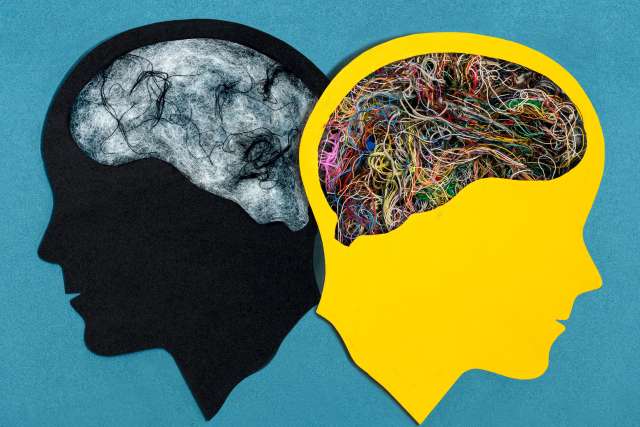A new study is gathering extensive data about people with bipolar disorder to improve diagnosis and treatment of this mental health condition that affects 40 million people worldwide, according to the World Health Organization.
UCLA Health is among six inaugural sites of the , which aims to enroll 4,000 participants for the study. Researchers intend to collect health metrics, brain scans, self-reported symptoms and data on movement and sleep from wearable trackers, over time, in what’s known as a longitudinal cohort study.
The BD2 Integrated Network also forms a learning collective among the research sites, helping scientists, clinicians and people with bipolar disorder learn from each other and analyze data in almost real time to improve clinical care.
“I’m not aware of any other mental health study of this scope,” says , principal investigator of the study at UCLA Health. “We’re collecting huge amounts of information, so that any scientist at any of the sites can bring an aim — a specific scientific question — and answer it with the data that we have available in this large longitudinal cohort.”
What is bipolar disorder?
Bipolar disorder is a mental health condition characterized by episodes of depression and mania that affects a person’s mood, energy and ability to function in everyday life. As many as 70% of people with bipolar disorder are misdiagnosed at least once, according to .
These episodes can be disruptive and last for weeks to months. During a manic period, a person experiences high energy and a decreased need for sleep. An individual may spend a week feeling restless, speaking rapidly, engaging in more activities than usual and experiencing uncontrollable racing thoughts. Depressive episodes, which are typically longer than manias, can last for months, during which individuals may feel intense sadness or hopelessness, and experience changes in sleep or appetite, along with thoughts of death or suicide.
While some people with bipolar disorder may cycle through these episodes within a few weeks or months, many don’t, Dr. Kruse says. There can also be periods of neutral mood and energy in between, sometimes for long stretches. The goal of treatment is to prevent these episodes, she says.
Treatment for bipolar disorder may include mood-stabilizing medication, such as lithium, but it is not effective for everyone, Dr. Kruse says. Though there are many treatment options available, she says, there are few predictors of response to individual treatment.
“For some patients who have bipolar disorder, we have to choose medications by trial and error to help them get well and stay well,” she says. Dr Kruse added that it often takes multiple different medication trials before patients begin to feel like themselves again.
One goal of the BD2 Integrated Network is to illuminate variations in the condition and personal characteristics that can help predict which treatments might be most effective for each individual. Reaching this goal would help patients spend more time feeling well by empowering them and their doctors to choose treatments that are most likely to help, based upon individual characteristics, Dr. Kruse says.
“It really has the potential to be transformative,” she says.
A comprehensive picture
Study participants will undergo annual brain scans, including structural and functional magnetic resonance imaging (MRI). Each individual’s biology will be studied annually through blood samples that test for hormone levels, genetic makeup, metabolic measures and inflammation. Study participants will also wear digital trackers that passively monitor their sleep, movement, heart rate and other metrics.
The five-year study includes annual visits with a clinician and multiple check-ins throughout the year to inquire about participants’ lives and any changes in sleep and mood. Participants will also complete self-assessment scales at various points during the study.
“It’s a huge data ecosystem that’s being created,” Dr. Kruse says.
This data ecosystem will be available for countless future studies of bipolar disorder. Among the potential studies Dr. Kruse and her colleagues at UCLA Health – including fellow investigators ; ; and – may undertake include explorations of how mood disorders affect cellular function and the complex relationship between bipolar disorder and obesity.
“It’s just reflective of the many different directions that we have the potential to go in for this study,” Dr. Kruse says. “There’s endless opportunity to delve in and to answer some of these questions.”
Improving care in near-real time
One aspect of the BD2 Integrated Network that’s particularly exciting to Dr. Kruse and other clinicians is its learning health network, with clinicians, patients and researchers sharing information and best practices as they emerge.
“It’s like a quality improvement approach — seeing things and then implementing changes based on what we’re seeing, but on a large scale, across institutions,” Dr. Kruse says. “It’s this community of clinicians and researchers collaborating with patients and trying to analyze data in as close to real time as possible, then implementing changes based on that data, similar to what has been done successfully with other disorders,” such as pediatric inflammatory bowel disease and pediatric cases of COVID-19.
The process of collecting and analyzing research data, disseminating the knowledge gained and translating findings into clinical practice typically takes many years. However, a learning health network aims to expedite this process and quickly transform data into actionable insights that improve patient care, says Dr. Kruse.
UCLA Health will first recruit participants for the new study from patient populations already being treated for bipolar disorder at its clinics, Dr. Kruse says.
“It’s an incredible opportunity for us to help our patients get well faster and to stay well,” she says. “I’m over the moon that we’re part of this and can help contribute to the improvement of people's lives over time.”






